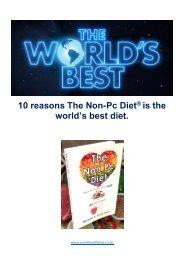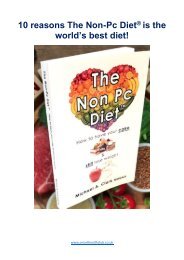TheNon-PCDiet®
Create successful ePaper yourself
Turn your PDF publications into a flip-book with our unique Google optimized e-Paper software.
This diagram has been reproduced from Dalmeny et al, Journal of the HEIA. (Dalmeny 04)<br />
Just look at these two pyramids the one on the left is meant to be healthy (not that<br />
healthy-but boy just look at the one on the right (WHICH REPRESENTS<br />
ADVERTISING BUDGETS SPENT ON FOODS) And for those who say there is no<br />
evidence to suggest advertising influences trends, then just one little question!! IF IT<br />
DIDN’T WORK WHY DO COMPANIES SPEND MILLIONS OF POUNDS EVERY<br />
YEAR ADVERTISING THEIR GOODS (oops or should that be bads).<br />
The imbalance between food advertising and the promotion of healthy foods and<br />
lifestyles is huge. For example, in 2000, food advertising in the UK amounted to just<br />
under £600 million for food and approaching £300 million for drinks. Only a small<br />
amount spent on fruit and vegetables, around £16 million, which also included the<br />
promotion of tinned and frozen products. Government research shows The Food<br />
Standards Agency spent less than £10 million annually on promoting better eating<br />
verses over £600 million on processed food adverts.<br />
Why are these products so heavily promoted? The simple answer is profitability. In<br />
the case of potato crisps and soft drinks, the cost of the basic ingredients is tiny often<br />
less than 5% of the marketed cost of the product. Hence the potential profits are<br />
huge even after paying for expensive advertising and slotting fees to supermarkets.

















